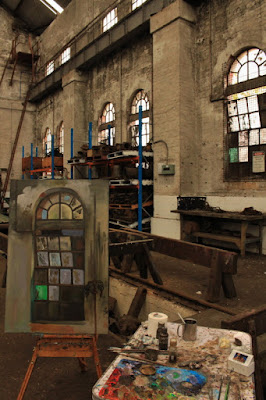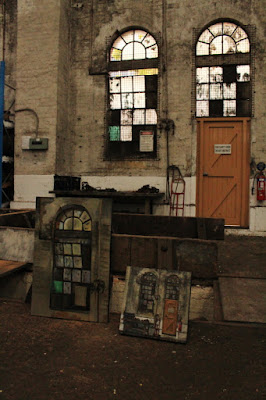Forget your perfect offering
There is a crack, a crack in everything
That’s how the light gets in.”
“Anthem,” by Leonard Cohen from his 1992 album The Future.

Starting a small square canvas 46 x 46cm
of two windows and a door in the
Large Erecting Shop, Eveleigh Railway Workshops
Enquiries
These are healing words to someone who often struggles under the unbearable weight of perfectionism. It is more than a confrontation with the strange beauty of broken things.
It is a powerful message of hope in dark times.There is a crack in everything whether a physical object such as a piece of machinery, or even a state of mind.
But that’s where the light gets in, and that’s where we can find the transcendence we need to interpret painful events in a wider context.
Literally, nothing, and nobody is perfect.That should not be a source of despair or frustration.
Imperfection is a sign of life.

Starting a small square canvas 46 x 46cm
of two windows and a door in the
Large Erecting Shop, Eveleigh Railway Workshops
Enquiries
If the purpose of a window is to be able to let an observer see outside, or to illuminate the interior, the windows of the Large Erecting Shop of the Eveleigh Railway Workshops fail spectacularly.

'2 windows and a door in the Large Erecting Shop,
Eveleigh Railway Workshops'
2017 oil on canvas 46 x 46cm
Enquiries
However, the evocative effects created by sunlight filtering through the grid of rusty bars rival the stained glass of Chartres Cathedral.

'2 windows and a door in the Large Erecting Shop,
Eveleigh Railway Workshops'
2017 oil on canvas 46 x 46cm
Enquiries
Every pane is a unique mix of translucency and texture.

Starting a 91 x 61cm canvas
of the strange green window.
" 2 windows and a door, Large Erecting Shop,
Eveleigh Railway Workshops' 2017
oil on canvas 46 x 46cm
Enquiries
Their ethereal opalescent quality is not caused by expensive designer frosting, but by more than a century's buildup of deposits of dirt, pigeon droppings, steam and diesel fumes.

Starting a 91 x 61cm canvas
of the strange green window.
Enquiries
And there are cracks galore.

Starting a 91 x 61cm canvas
of the strange green window.
Enquiries
Other imperfections abound.

Half finished 91 x 61cm canvas
of the strange green window.
'2 windows and a door in the
Large Erecting Shop,
Eveleigh Railway Workshops'
2017 oil on canvas 46 x 46cm"
Enquiries
Ghost signs warning of the dangers of long lost machinery alternate with boarded over panes in abstract patterns that would make Mondriaan's head spin.

Half finished 91 x 61cm canvas of the strange green window.
Enquiries
Doors are abruptly cut into them, apparently at random.

Half finished 91 x 61cm canvas of the strange green window.
Enquiries : janecooperbennett@gmail.com
An inexplicably green pane of glass casts an eerie phosphorescent glow.

"Window with pane of green glass"
2017 oil on canvas 91 x 61cm
Enquiries
When the Large Erecting Shop is redeveloped, the windows will be replaced with uncracked clear panes to match the rest of the gentrified ATP.
No rogue panes of eldritch green glass will startle the viewer with their otherworldly light. They will be made safe, watertight, functional, identical and boring.
The chaotic jumble of heritage machinery in the Large Erecting Shop will be culled and tamed. There will be nothing accidental, mysterious or inexplicable.
There will soon be no cracks left to let the light in.
More paintings of the Eveleigh Railway Workshops
Related Posts
The fire within

























